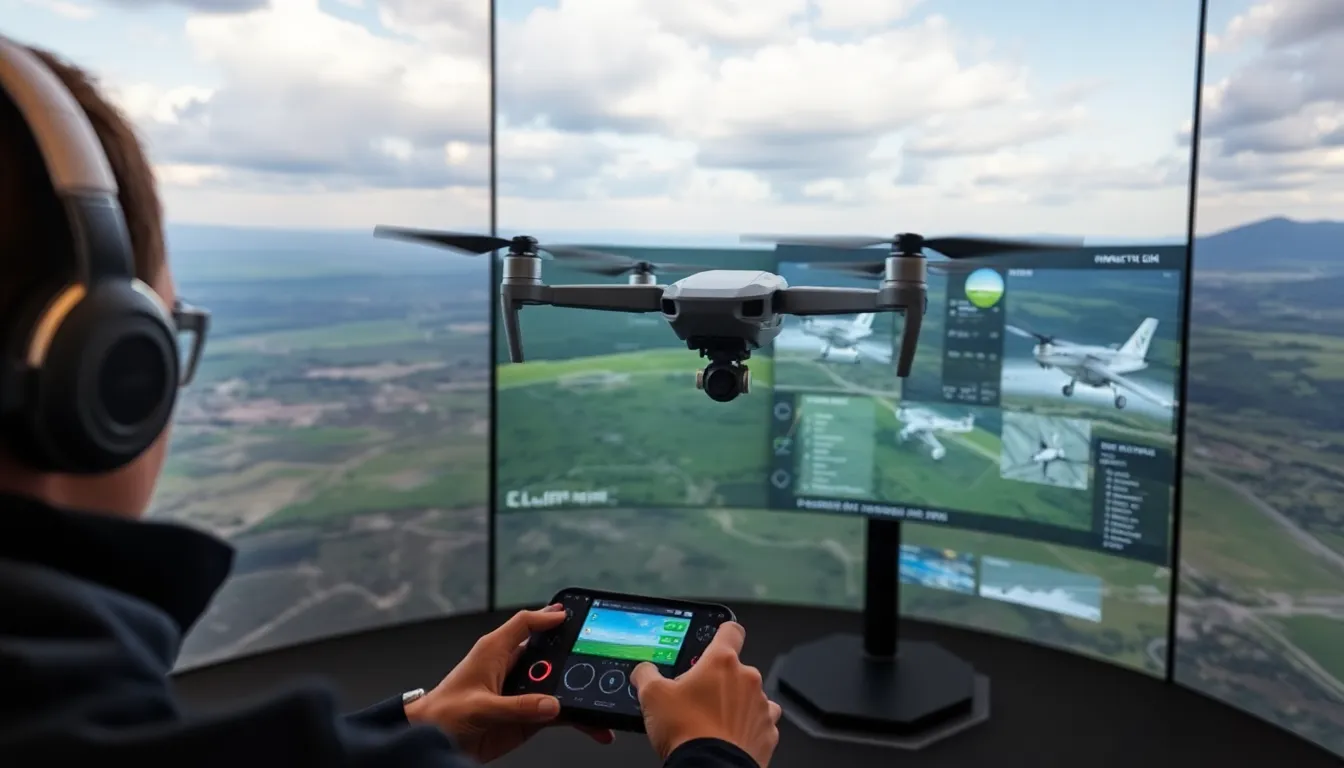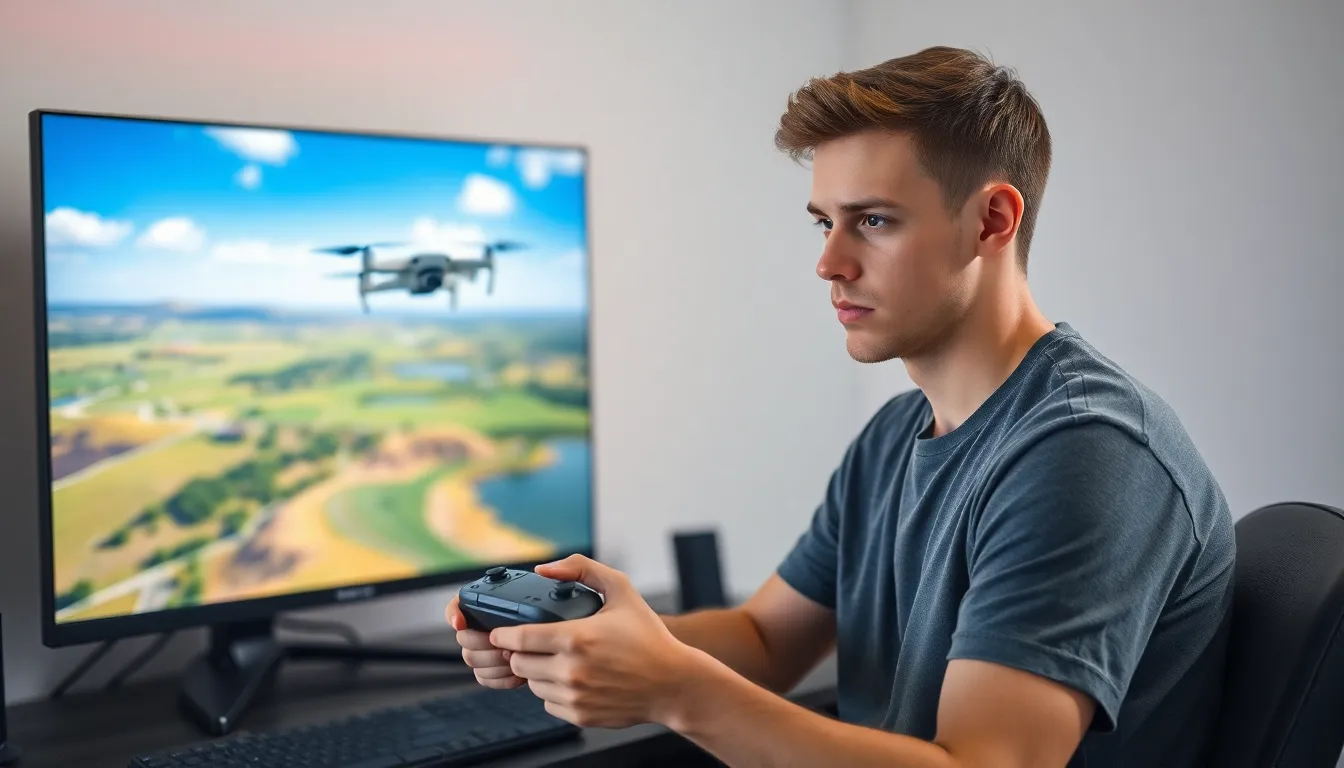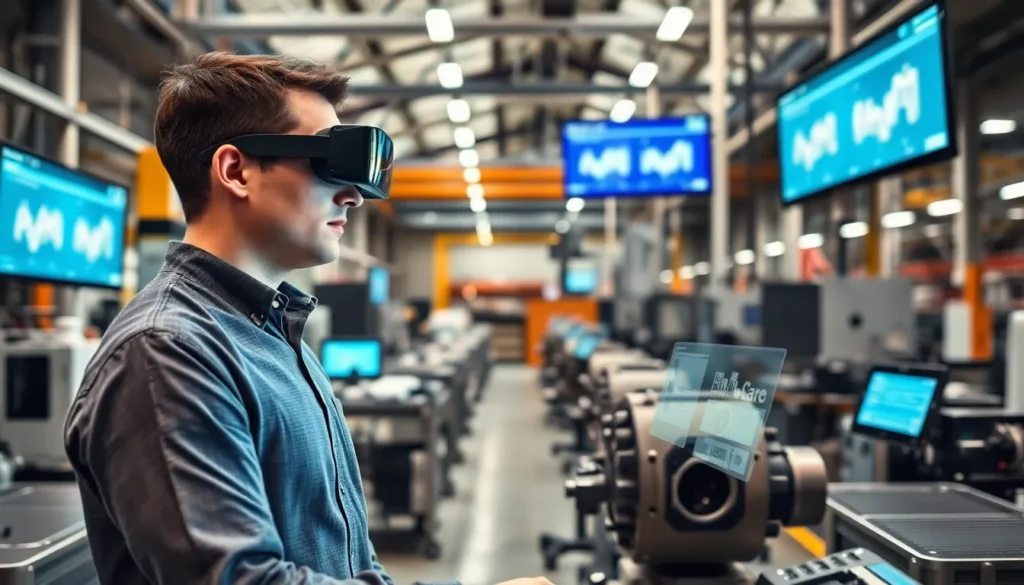Imagine soaring through the skies, piloting a drone like a pro, all from the comfort of your couch. With a drone flight simulator, that dream is just a download away. No need to worry about crashing into your neighbor’s tree or accidentally photobombing a wedding. Instead, it’s all about mastering the art of flight without the fear of a hefty repair bill.
These simulators offer a fun and realistic way to learn the ropes of drone operation. Whether you’re a curious newbie or a seasoned pilot looking to refine your skills, there’s a simulator tailored just for you. Get ready to navigate through virtual landscapes, dodge imaginary obstacles, and impress your friends with your newfound aerial prowess—all while keeping your feet safely on the ground. Who knew flying could be this entertaining?
Table of Contents
ToggleOverview of Drone Flight Simulators
Drone flight simulators replicate real-world flying experiences in a controlled environment. They serve as a training tool for drone enthusiasts and professionals alike. Platforms like RealFlight and DRL Simulator offer realistic physics and graphics, enhancing user experience. Users can select various environments, from urban landscapes to open fields, allowing for diverse practice scenarios.
These simulators incorporate various drone models, enabling users to understand different flight characteristics. Beginners can learn the basics of flight controls, while experienced pilots can refine their skills through advanced maneuvering challenges. The flexibility to adjust settings, like wind speed and weather conditions, makes practice more representative of real flying conditions.
Costs associated with drone flight simulators vary widely. Some basic options are free, while advanced software packages can range from $30 to $200. Hardware requirements generally include a computer with decent specs and a compatible controller for optimal performance. Many simulators support popular game controllers or specialized RC transmitters, enhancing interactivity.
Feedback systems integrated within simulators provide valuable insights. Users receive real-time analysis of their performance, helping identify strengths and areas for improvement. This feature adds an educational aspect, enabling pilots to track their progress over time.
Overall, drone flight simulators effectively bridge the gap between theory and real-life flying. They cater to a range of users, from hobbyists seeking an enjoyable experience to serious pilots preparing for specific missions. Engaging with these simulators represents a commitment to skill enhancement while eliminating safety risks associated with actual drone operation.
Features to Consider

Several features enhance the experience of using a drone flight simulator. Users should prioritize these aspects to maximize their training and enjoyment.
Realism and Accuracy
Realism plays a significant role in a drone flight simulator’s effectiveness. Users benefit from accurate physics that simulate real-world flight dynamics. Graphics depicting various environments contribute to immersive training experiences. The closer the experience mimics actual flying, the more valuable the simulator becomes. Many simulators, like RealFlight and DRL Simulator, strive for high fidelity in flight mechanics and environmental representation. Users can expect realistic reactions when performing maneuvers, which aids in developing proper piloting skills.
User Interface
A user-friendly interface determines how easily individuals can navigate simulations. Intuitive controls allow users to focus on flying rather than grappling with complex menus. Clear layouts and simple access to features enhance overall engagement. Additionally, good simulators provide customizable controls, enabling pilots to tailor their settings for individual comfort. Easy-to-read displays make monitoring flight parameters seamless. Prioritizing these elements can lead to a smoother and more enjoyable simulation experience.
Customization Options
Customization options allow users to modify drones and settings to suit their preferences. Users appreciate the ability to experiment with various drone models and specifications. Many simulators offer diverse settings for different skill levels, from beginners to advanced pilots. Settings can include adjusting flight physics difficulty or selecting unique environments. Personalized settings ensure that users face challenges that match their experience level. Variety in customization fosters a deeper understanding of drone capabilities and enhances skill development.
Popular Drone Flight Simulators
Drone flight simulators provide diverse options for enthusiasts looking to enhance their flying skills. Users can select from various platforms based on specific needs and preferences.
Simulator A
RealFlight stands out as a leading choice for drone training. It features realistic physics and stunning graphics that create an immersive flying experience. Users appreciate its variety of customizable environments, which aid in skill development. The simulator supports numerous drone models, allowing pilots to learn the nuances of different aircraft. With a price range starting at $99, it offers a comprehensive solution for serious drone enthusiasts. Integrated tutorials guide users through various challenges, ensuring continuous improvement in flight techniques.
Simulator B
DRL Simulator caters particularly to racing enthusiasts. It emphasizes fast-paced scenarios, providing users with the thrill of competitive flying. Realistic flight dynamics simulate the experience of racing drones in actual events. Pilots can compete against others in global online leagues, fostering a sense of community among users. The simulator is available for around $19.99, making it an accessible option for pilots looking to improve their racing skills. Additional features like real-time performance analysis assist users in tracking their progress and developing better strategies.
Simulator C
FPV Freerider has gained popularity for its straightforward approach to flying. Designed with beginners in mind, it offers an intuitive interface that simplifies the learning process. Users can choose various landscapes, making each session unique and engaging. Priced at $14.99, it remains budget-friendly while providing essential training elements. The simulator encourages users to experiment with different flying styles, promoting creativity and confidence in their piloting skills. The easy-to-navigate controls help even novice pilots get acclimated quickly.
Benefits of Using a Drone Flight Simulator
Using a drone flight simulator provides numerous advantages for both novice and experienced pilots. Learning to pilot a drone in a safe, controlled environment minimizes risks associated with real-life flying. Practicing in virtual landscapes allows users to build confidence while mastering flight controls without the fear of damaging equipment.
Realism plays a significant role in the effectiveness of these simulators. Platforms such as RealFlight and DRL Simulator offer high-fidelity physics and graphics, closely mimicking actual flight dynamics. This enhances the training experience, making skill development more engaging and effective. Users can select diverse environments for practice, which increases familiarity with various flying scenarios.
Customization options further enhance learning opportunities. By modifying drones and settings, users can tailor the simulator to match their skill levels. Such customization fosters a deeper understanding of drone capabilities, contributing to improvement in flight techniques.
Many simulators include integrated feedback systems. Real-time performance analysis helps users track progress and identify areas for improvement. This level of feedback is essential for targeted skill enhancement, making users more adept pilots.
Cost-effectiveness adds to the appeal of drone flight simulators. Some options are free, while others range from $30 to $200. Users can find a solution that fits their budget, making training accessible for enthusiasts and serious pilots alike.
Engaging with these simulators not only provides entertainment but also strengthens flying skills. The unique features of various simulators cater to different preferences and skill levels. Overall, the benefits of using a drone flight simulator create a comprehensive training tool, bridging the gap between theoretical knowledge and practical flying experience.
Drone flight simulators offer an invaluable tool for both novice and experienced pilots. They provide a safe and engaging environment to hone flying skills without the risks associated with real-world operation. With a variety of options available catering to different interests and skill levels, users can find a simulator that suits their needs.
The realistic graphics and physics enhance the learning experience, making it easier to grasp complex maneuvers. As users navigate diverse virtual landscapes, they can track their progress and gain confidence in their abilities. Embracing drone flight simulators not only elevates flying skills but also fosters a deeper appreciation for the art of piloting.





